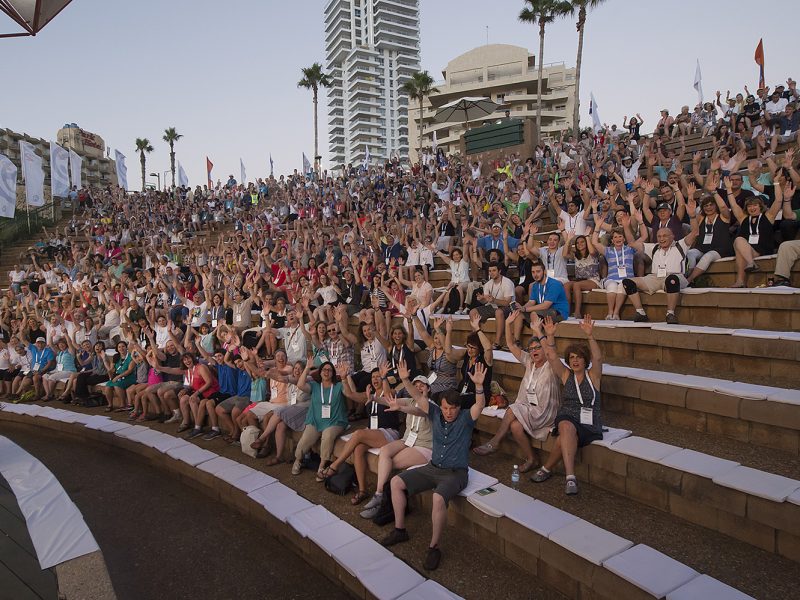Danielle V. Minson — Raising the Bar

Eight Rabbis, a Federation and a Foundation Walk into Jerusalem: It’s Not a Joke
This piece was just published on October 7, in eJewish Philanthropy.
It sounds like a joke. But there they were—eight rabbis sitting together—one Humanist, several Reform, a Conservative, and an Orthodox in the new Haas Promenade overlooking Jerusalem. Having 508 members of the Cincinnati Jewish community together during this summer’s 2016 Cincinnati Congregation and Community Israel Mission got the headlines. But even more significant was the fact these eight rabbis, after ten days in Israel together, felt more connected to each other and to the overarching community.
The trip they had just completed was neither a congregational Israel trip nor a federation Israel trip. It was a congregation and community Israel mission.
Historically, federations and congregations have run Israel trips separately. For more than a century, the federation-congregation relationship mirrored America’s “separation of church and state.” Matters of general social welfare were led by federations and separated from the affairs of congregations.
But when the 1990 National Jewish Population Study announced that more than 50 percent of Jewish marriages were intermarriages, federations realized that, if we wanted a Jewish future in America, maintaining Jewish identity needed to become a top priority for federations and congregations alike.
Israel trips remained an important way to deepen Jewish identity. But community members had to choose either congregational trips (which brought together family members to experience Israel through the eyes of their rabbis) or federation/community missions (which offered access to Israeli political and thought leaders and focused on the building and protection of the Jewish state).
In recent years, our federation has sought to shift its role—creating fewer federation-owned programs and instead providing more community-wide platforms, like this trip, to optimize programs owned by our congregations and agencies.
So my colleague Barbara Miller, our Director of Community Building, and I collaborated with our officers and congregational rabbis on a model that gave congregations full flexibility to build their own itineraries, to recruit on the congregational level, and to select professional tour educators who matched their styles and viewpoints.
The separate itineraries were balanced by time together: all participants stayed in the same hotels, shared many meals and drinks together, and attended three community-wide events, featuring A-list speakers and performers.
The success of this model was multiplied by Cincinnati’s incredible good fortune—we have a large, high-impact foundation, The Jewish Foundation of Cincinnati, that was greatly expanded by the 2010 sale of our Jewish Hospital. In fact, The Jewish Foundation helped inspire the 2016 mission from the beginning by emphasizing the value of belonging to a congregation, and by elevating the significance of rewarding committed members. The Foundation provided generous subsidies, which enabled many families to participate who otherwise would have been unable to afford the cost.
“Our trustees viewed this initiative as a perfect way to strengthen our investment in the Cincinnati Jewish community,” said Jewish Foundation Executive Director Brian Jaffee. “Throughout the process of planning and implementing this mission, more than 500 people saw how their congregations and their community can work together on experiences that matter to them. As a result, their relationships with their synagogues, with the community as a whole, and with Israel have become more dynamic.”
Balancing collaboration with political realism and autonomy also turned out to be necessary. As Rabbi Barr explained, “Given the diversity across denominations, this trip had to exhibit a respect for the authentic expression of each congregation involved. For example, the idea was floated about having a communal Shabbat. But once there was an honest dialogue about the individuality of Shabbat practice among congregations, it was clear the best way to respect everyone was to allow everyone to do it on their own.”
As the summer fades, our federation and congregations are challenged to keep the warm glow of this epic trip burning. To quote Rabbi Barr, “This trip affirmed that with trust, dialogue, and mutual respect, we can achieve something beyond what we could have conceived of.”
Now, the question is, will we have the stamina, savvy, and creativity to build on the “trust dividend” that the trip created?
We must meet this challenge because only if federations, foundations, and congregations devise fresh, mutual approaches to building inclusive communities and enhancing Jewish identities will we have the best chance of thriving during these volatile and confusing times. It’s a daunting task, but when I need inspiration, I think back to the improbable sight of our community rabbis, sitting together, gazing over Jerusalem.

